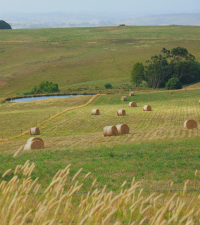
The Science Based Targets initiative (SBTi) provides a critical framework for companies to align their sustainability goals with scientific insights on climate change. The introduction of FLAG Guidance enhances this framework by offering specific guidelines for setting land-based targets, an area that previously lacked clear direction.
SBTi FLAG Overview
FLAG Guidance is particularly relevant for large enterprises engaged in SBTi target-setting, offering a structured approach to addressing land sector emissions. While FLAG targets are not mandatory for companies who aren’t setting SBTs, an expedited pathway exists for small and medium enterprises who opt to adopt these targets as part of their sustainability efforts.
SBTi FLAG empowers companies to set and pursue targets for reducing land sector emissions, in line with LSR’s categories of emissions and removals.
Beginning with the calculation of baseline emissions in accordance with SBTi’s guidance, companies can then strategically set targets and develop a timeline for achieving them. This is especially crucial considering that land sector emissions account for about 22% of global emissions, but have been identified as having the potential to deliver 30% of emissions reductions by 2050. This presents both a unique challenge and opportunity for industries heavily reliant on land resources, such as the food industry.
Land Sector Emissions Reductions
To effectively harness nature-based solutions for carbon sequestration, a process more naturally efficient than many current technological methods, companies need access to detailed emissions factors and a consistent framework for assessing FLAG emissions across their entire portfolio. This includes the ability to trace raw materials through all supply chain stages and the agility to adapt strategies using dynamic tools.
Beyond setting and reporting emissions baselines, companies need a robust strategy to systematically reduce emissions and regularly measure and communicate their progress. This requires both a comprehensive internal approach and adherence to global reporting standards.
Carbon Reduction Solutions for the Food Industry
HowGood’s Latis platform is specifically designed to provide food companies a way to meet these strategy and reporting requirements. With 17 years of global food supply chain research and data from over 600 accredited sources, Latis delivers the data granularity required by the GHG Protocol product standard. Its reporting capabilities are fully aligned with frameworks like CDP and GRI, making it a trusted solution for enterprise food brands and retailers globally. Latis not only provides reliable data but also supports dynamic innovation and scenario planning, helping companies effectively meet their environmental targets.
In this video, HowGood’s Chief Innovation Officer, Ethan Soloviev, demonstrates how food companies can automate and streamline their FLAG measurements, management and reporting. Highlights include:
- Decarbonization strategy with cross-functional teams
- Reliable data solutions and granular data
- Land use change and land management emissions
- Pathways to reduction and long-term strategy



.png)
